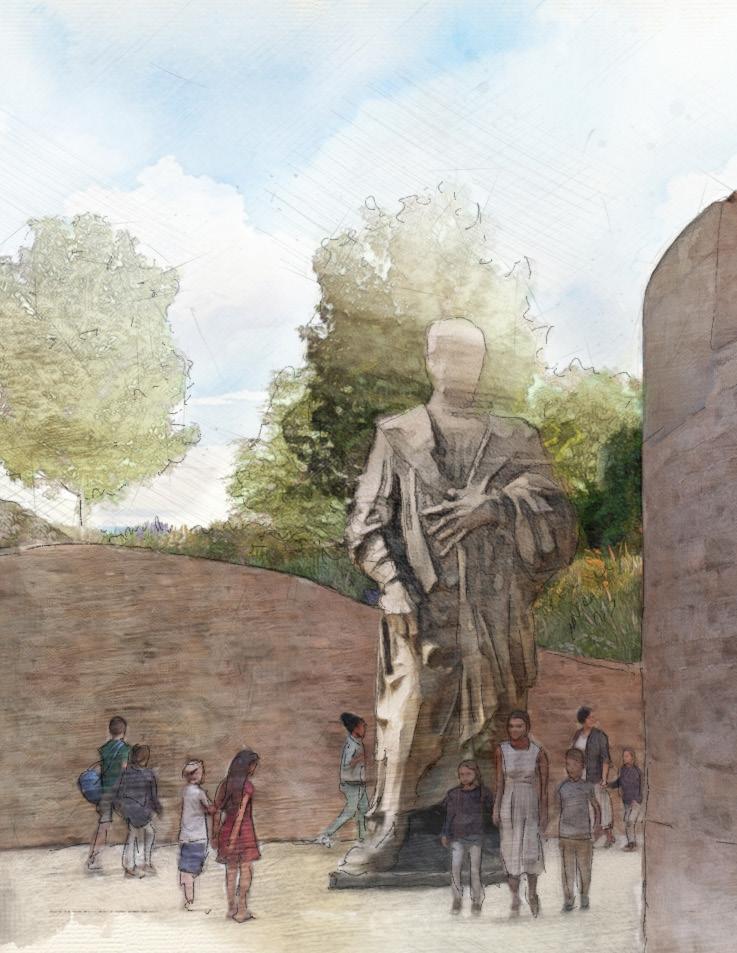




Over the course of six books, this report fully details the activities and outcomes of the Reimagining Columbus project, through which the City of Columbus, Ohio reckoned with its relationship to the explorer Christopher Columbus.
THE SIX BOOKS IN THIS SERIES INCLUDE:
BOOK # 1
provides insights into how the City of Columbus came to display a Christopher Columbus statue on the grounds of its City Hall, why that statue was removed in 2020, and how the Reimagining Columbus project was designed to help the city determine what to do with it going forward.
BOOK # 2
describes research the project team undertook to discover the many stories that have played out among the people of Columbus, Ohio since long before it became a city, the truth of Christopher Columbus and his conduct in the New World, and how an explorer who never reached the United States became a symbol of all its promise.
BOOK # 3
outlines the community engagement methodologies employed throughout this project and chronicles the events and activities offered by the Reimagining Columbus project team, as well as findings from these conversations.
BOOK # 4
connects the project team’s research findings and community engagement results to the design principles that informed concepts for a new space in which residents might one day experience the reinstalled Christopher Columbus statue.
BOOK # 5
applies the design principles developed from research and community conversations, and best practices in placemaking, to articulate how a new statue site should look and feel, how visitors should be able to interact with it, and how it could engender profound experiences that reverberate for generations.
BOOK # 6
offers an Art Plan for City Hall Campus to guide the implementation of future public artworks there.

Original materials developed through this program are available at reimaginingcolumbus.com , or upon request.
Reimagining Columbus is funded by the Mellon Foundation’s Monuments Project, a multi-year commitment aimed at transforming the nation’s commemorative landscape to ensure our collective histories are more completely and accurately represented.

Book 5 of the Reimagining Columbus Final Report is the culmination of learnings from the project’s research activities (Book 2), community engagement conversations (Book 3), and design ideations (Book 4). As no funding or site on which to realize it have yet been identified, the vision it offers for a new space in which to install the Christopher Columbus statue is a recommendation at this point. The City of Columbus has, however, committed $1.5 million to install new public art at City Hall in accordance with the City Hall Campus Art Plan (Book 6).
Within this Book, the design team has evolved preliminary sketches from Book 4 into detailed conceptual renderings of each of the seven visitor moments proposed. There is also additional detail regarding site elements and flow, as well as potential plantings, interior spaces, and public art. Several options for the disposition of the Columbus statue are presented for consideration. Text is sparse, allowing the illustrations to speak for themselves; it is hoped that they will inspire an expansive take on what is possible for this space and generate community enthusiasm to enable its realization.
All site renderings in this Book were created by Designing Local and CBenick Digital Illustration. All other maps and images were created by Designing Local.
• The renderings herein fulfill a deliverable for the Reimagining Columbus Mellon Foundation grant — the conceptual design of a new space in which to display the city’s Christopher Columbus statue.
• Renderings do not reflect an actual site or approved designs, and no commitment to implementing a site similar to this has been made at this time. Rather, all materials in this book cast a generational vision for what such a space might look like and include.
• The imagined site features seven experiential moments that, collectively, would tell the stories of both Christopher Columbus and the City of Columbus. Another process would be necessary to ascertain what messages should be communicated in each space, and how they should be delivered.


The concept imagined for a new Columbus statue installation is ambitious and includes multiple spaces for different purposes. This section reveals the full site concept and maps its various elements.


ADJACENT PARKLAND

COMMUNITY GATHERING SPACE
MIDDLE TERRACE
LOWER TERRACE
RIVER ACCESS
RIVER OVERLOOK

PEDESTRIAN BRIDGE
PADDLECRAFT LAUNCH
RIVER OVERLOOK
ARRIVAL
COMMUNITY GATHERING 1 2 3 4 5 6 7 LOOKING TO THE FUTURE
HISTORICAL CONTEXT & TIMELINE
THE STATUE
REFLECTION
NATURE PLAY & LEARNING
CANOPY WALK
DESTINATION PLAYGROUND
EVENT SPACE & COMMUNITY ROOM

REFLECTION SPACE
LOBBY & THEATER

The renderings in this plan focus on the site's exterior spaces. Ideally, the space would also include the following interior elements:
• Additional interpretive features
• Gallery space for both permanent and temporary exhibitions
• Classrooms and small meeting spaces
• A theater to host community performances
• A lobby with reception space for visitors
• Infrastructure to support artist-inresidence programming
• A community library


Materials and architectural styles for the space should feature:
• Different types of native plant communities
• Natural materials and curvilinear forms
• Native stone with architectural detailing
• An abundance of vertical surfaces for public art and interpretive content

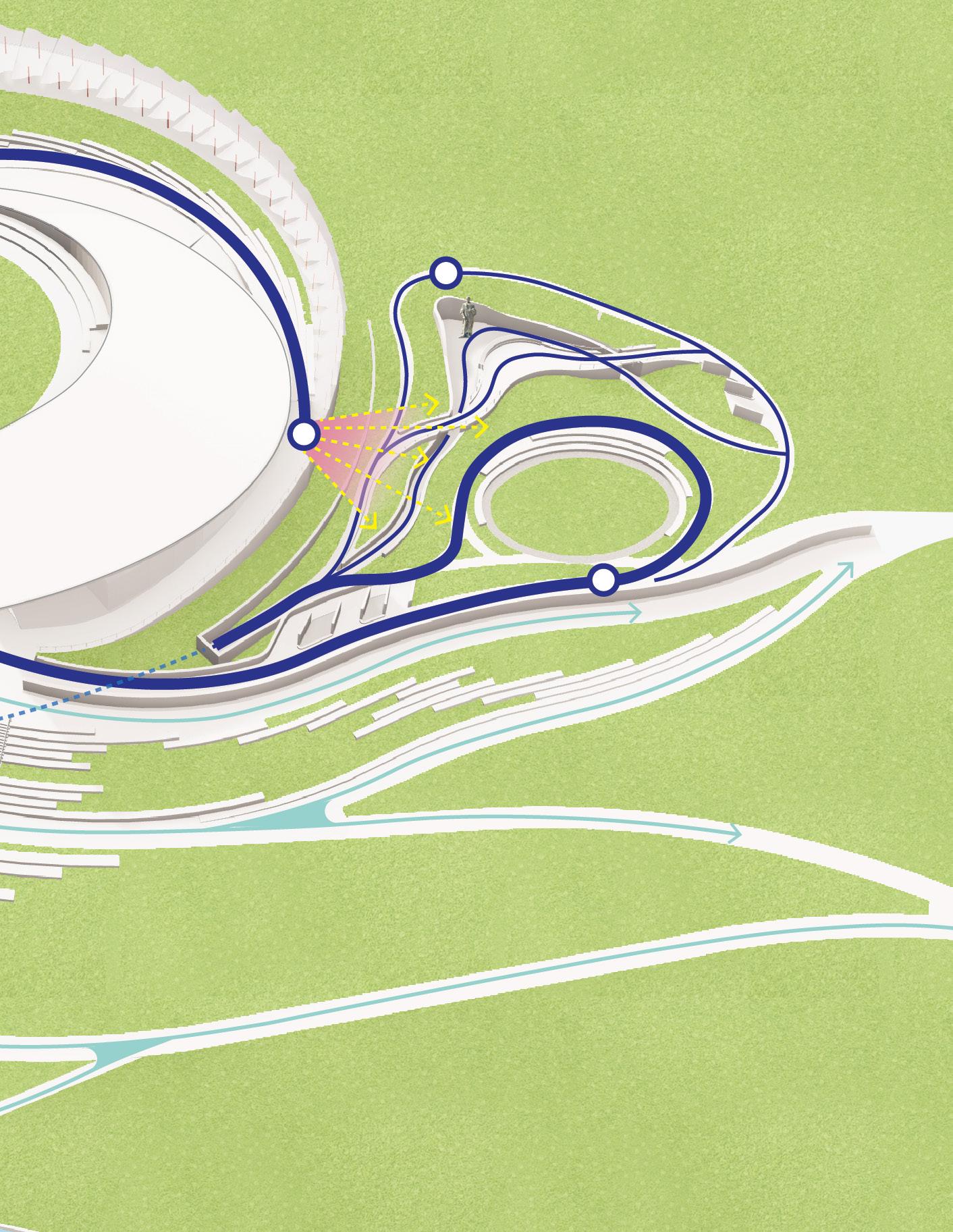
The design team envisioned a visitor experience with seven moments, each offering a distinct purpose and emotional quality. This section describes these moments and shows their relationship to one another via a site map.
MIDDLE TERRACE
Visitors enter from the east, the direction of the sunrise and new beginnings, and are welcomed into an expansive central greenspace designed for community programming and cultural exchange.
LOWER / CULTURAL / SCULPTURE GARDEN
Visitors encounter panels designed to offer a candid examination of the city’s history and how it intersects with the full, true story of Christopher Columbus and those who were impacted by his actions.
LOWER GARDEN
Visitors choose whether to view the Christopher Columbus statue, which has been placed at the lowest feasible elevation on the site's north side to symbolize the past. Those who do so are given the information to confront everything, for better and worse, that the statue and its subject represent.
LOWER TERRACE
Visitors, facing the river, experience a quiet moment of reflection to ground themselves in nature. The space is sheltered from the elements and offers a soundscape, wide natural views, and art. It is meditative, contemplative, sheltering, and comforting, providing calm for those who experience difficult emotions upon viewing the statue.
RIVERFRONT
Visitors enjoy moments of nature-based learning and play throughout the site, with opportunities for intergenerational interactions at the riverfront or natural playgrounds.
MIDDLE TERRACE, CENTRAL
Visitors gather for community cultural events, festivals, and passive enjoyment in a central lawn that is bordered by a museum-like venue with spaces for art exhibits, classes and workshops, a library, a theater, and more.
UPPER GARDEN
Visitors take in an expansive view of the garden and the city beyond in a space featuring future-focused interpretive programming and content showcasing evolving hopes for what the City of Columbus can become.
MOMENT 6: COMMUNITY GATHERING SPACE

MOMENT 1: ARRIVAL
MOMENT 4: REFLECTION
MOMENT 5: NATURE PLAY & LEARNING
MOMENT 3: THE STATUE

MOMENT 2: HISTORIC CONTEXT & TIMELINE
MOMENT 7: LOOKING TO THE FUTURE


Visitors enter from the east — the direction of the sunrise, representing new beginnings — and are welcomed into an expansive space surrounded by trees and native plantings. This section offers a rendering that depicts how designers imagined what people would see as they enter a new space for the Columbus statue.


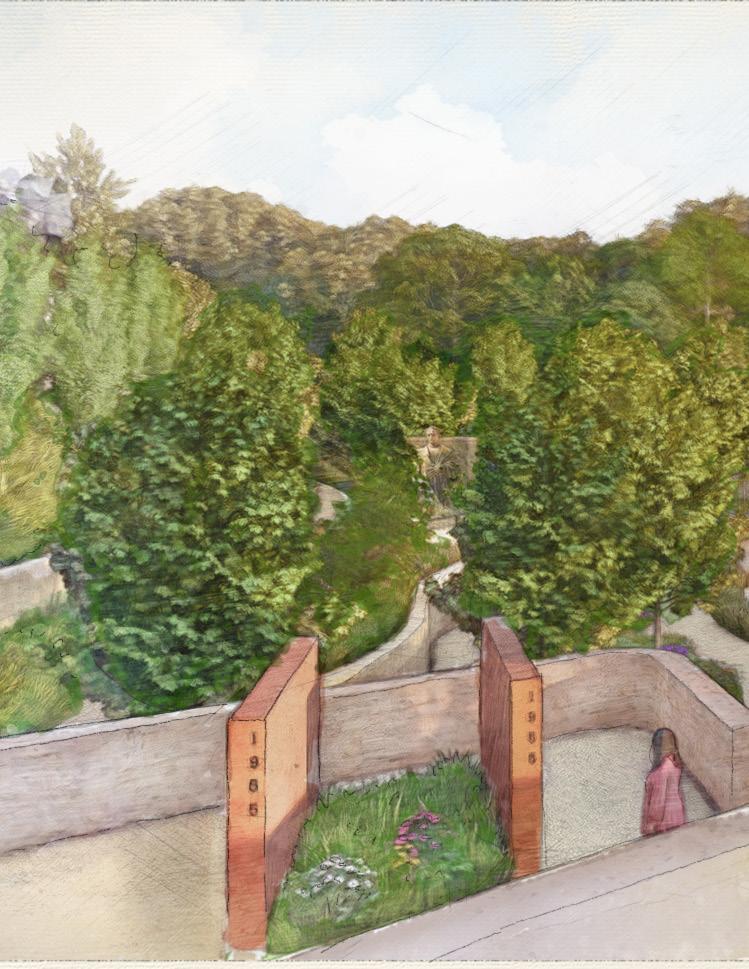
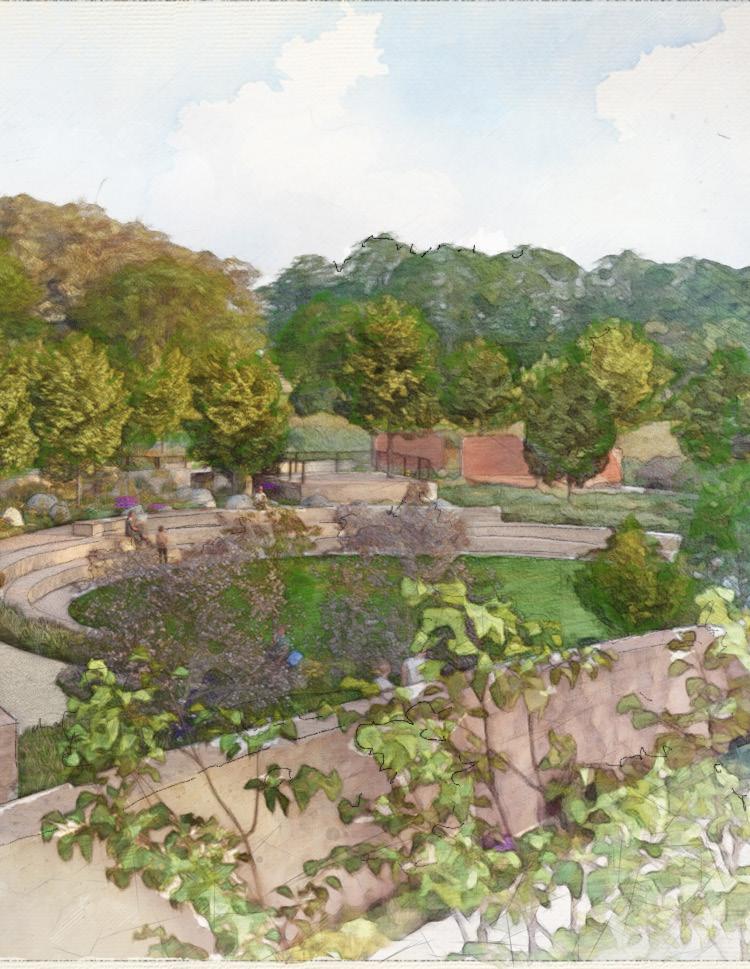
Visitors encounter interpretive panels that honor residents’ desire for the truth about Columbus and an accurate reflection of their own stories. This section presents design concepts for these panels and other storytelling structures, as well as where they might be located throughout the space.

















Visitors are invited to experience the recontextualized Columbus statue, which is placed at more human scale in the northern part of the space — the direction of the winter winds, representing trials and necessary cleansing. This section shows ways the statue could be displayed and the reasoning behind each option.



Statue Disposition 1. The first possible statue placement is a secluded, almost sacred or contemplative garden space with abundant plantings along a winding path. The statue is partially visible and set against the stone wall that rises behind, but it is not the sole focal point of the space. This setting reduces the statue's political charge by placing it in a lush, natural setting that offers viewers escape and reflection — allowing them to experience the figure on personal, rather than civic, terms. The focus is less public celebration of a heroic figure than private contemplation of a relic.

Statue Disposition 2. A second possible statue placement simplifies the landscaping and path around it, narrowing viewers' primary approach and making the statue slightly more dominant against the wall behind. Removing the garden on the wall near its base increases the statue's visibility and brings focus to the physicality and identity of the figure himself. The statue shifts from being a feature in the landscape to a more assertive focal point in the space.

Statue Disposition 3. A third possible statue placement physically constrains the statue within a surrounding wall and emphasizes this containment with a particularly narrow path. The statue here must be viewed not as a centerpiece of history, but as a historical artifact that is literally walled off from a contemporary civic space. The design implies that the controversial nature of the subject requires it to be viewed from a distance or through a defined passage. This is a common strategy for acknowledging a subject's toxicity while preserving it for study — it is present, but intentionally restricted.

Statue Disposition 4. A fourth possible statue placement orients the figure within a social context, with Columbus in direct dialogue with viewers whose experience of him is prioritized over the piece's original intent (i.e., to be in a place of prominence, high on a plinth). The statue is no longer a monument to be either revered or ignored, but a catalyst for conversation; it is not a historical endpoint, but a starting point for discussions about history's impact on the community today. Of note —this disposition provides the best access to the statue for cleaning, snow removal, and security.
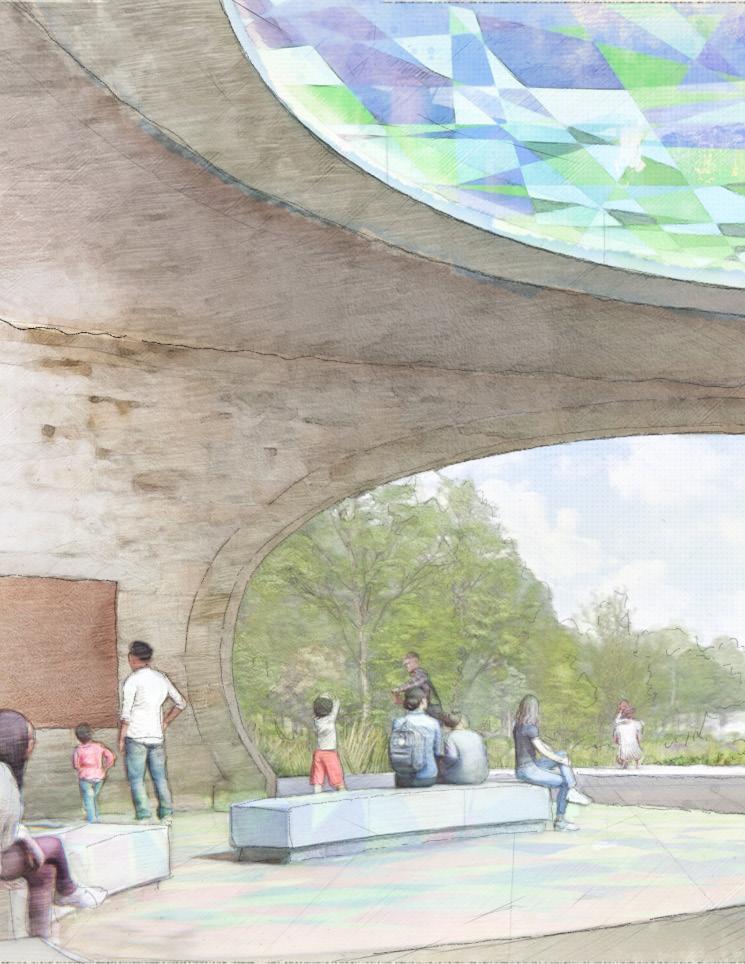

Following the statue experience and timeline, visitors can choose to reflect upon their experience and ground themselves in nature within a sheltered space that offers an expansive view of water and native plantings. This section shows a rendering of what such a space might be like.




Opportunities to interact with nature are scattered throughout the space, with some options that are designed and others that are wild. Access to water, rocks, trees, and dirt allows endless possibilities for unscripted play, recreation, and groundedness. This section provides a rendering of people enjoying a waterfront space with a natural playground nearby.




Visitors head westward — the direction of community, introspection, and maturity — to gather with others at the central lawn, which is fully equipped with event infrastructure and features concentric seat walls and shade structures. This section shows views of what a central gathering space could be.






Visitors experience breathtaking views of the gardens, the space in its totality, the river, and the city skyscape beyond. They are inspired by the scene before them, and at peace. This section reveals additional views of the full site, as well as a possible canopy walk.








A space such as the one proposed will offer ample opportunities for public art. This section offers ideas for art installations that could augment the seven moments with meaningful stories that enrich visitors' experience.
The public art ideas for Moment 2 respond to content that can be found in Book 2 of the Reimagining Columbus Final Report.
"Scioto River Mounds" Interactive Installation
This project could be a tactile installation representing the numerous earthworks that once existed along the Scioto and Olentangy rivers. It could use natural materials like packed earth and native plants. Digital components, such as a projected light show or an augmented reality app, would overlay images of what the mounds would have looked like when they were built and explain their cultural significance.
"Moundbuilders Heritage" Sculpture Garden
A series of sculptures or carved monoliths could be placed throughout the interpretative area, with each piece representing a different aspect of the Moundbuilders' culture — their astronomy, agriculture, or artistry. The sculptures could be crafted by Indigenous artists and include plaques providing historical context.
A collection of murals painted on walls of the interpretative area could tell the story of the various Indigenous tribes that inhabited Ohio, such as the Shawnee, Delaware, Wyandot, and Miami. Each mural could be a collaboration between a contemporary Indigenous artist and a local historian, ensuring both artistic expression and historical accuracy.
This project could be a nighttime installation along a riverbank, and it could be temporary. Using a combination of projected light and sound, it could tell the oral histories and creation stories of the local tribes. The sounds could be a mix of traditional music, spoken word, and nature, creating an immersive and respectful experience.
"Highbank Proprietors" Installation
This series of work could be four interconnected bronze or steel figures, representing the abstracted and stylized figures of Franklinton proprietors John Kerr, Lyne Starling, John Johnston, and Alexander McLaughlin as they stand on the riverbank, surveying land for the new city. Embedded in the ground around the installation could be plaques or a key that shows the original plat map and highlights how the land was divided.
This project could take the form of an interactive wall or a series of large, etched glass panels. One side could display historical documents and maps of the original plat, while the other could contain hidden stories and facts that the viewer could "unlock" by pressing buttons or using an app. This would allow visitors to explore the complex motivations behind the founding of Columbus, including the financial deal and the political maneuvering.
"Ohio Statehood" Banners
A series of large, colorful banners, each depicting a key moment in Ohio's early history, such as the signing of the statehood act or the first meeting of the General Assembly, could be displayed. The designs could be commissioned from local artists and be replaced seasonally, keeping the project fresh.
"Growing Community" Portrait Series
This project could consist of a series of bronze busts or large-scale, relief portraits mounted on a wall or a series of pedestals. The portraits could feature key figures from this period, celebrating the city’s growing diversity and visually representing the human stories behind its population growth. The series could include a mix of individuals, such as an early Irish or German immigrant, a prominent African American leader like Rev. James Preston Poindexter, a notable abolitionist, and a canal worker.
"Underground Railroad: A Silent Journey" Memorial
This could be a poignant and solemn memorial that uses minimalist design to evoke the courage of the Underground Railroad. It could be a series of weathered steel or stone pillars arranged in a subtle pathway, representing the journey to freedom. The pillars could be deliberately unadorned, allowing visitors to project their own emotions and reflections onto the art. Interpretive plaques could provide information about the local safe houses and conductors, offering a tribute without being overly graphic.
A sculpture could represent the economic heart of the city during this period. It could feature a stylized canal boat or a series of interconnected gears and levers, symbolizing the city's burgeoning industry and trade. This piece could serve as a permanent reminder of how the river and its new transportation networks drove the city's early development and attracted new residents and businesses.
"The Immigrant's Trunk" Sculpture Series
This project could be a series of bronze or steel sculptures shaped like old-fashioned trunks or suitcases. Each one could have etchings or reliefs on its surface that tell the story of a specific immigrant group from this period — Italians, Greeks, Jews, Hungarians, and Poles. These trunks would symbolize the journey, the stories, and the contributions each community brought to Columbus.
A large, woven, or textile art installation could be suspended. The weaving could use different colors and textures to represent the diverse threads of the city's growing population. Each thread could symbolize a different group — the native-born, the foreign-born, African Americans, and various immigrant communities — coming together to form the new, complex fabric of Columbus.
"Population Markers" Engraved Sidewalk
This piece could be a series of subtle engravings, at equidistances, that mark a different census year and the corresponding population numbers for Franklin County and the City of Columbus. This would provide a tangible, walkable timeline of the city's rapid growth, allowing people to literally walk through its demographic history.
This project could be a series of light patterns embedded in a panel depicting key intersections tracing the historical path of the streetcar lines that once connected the city. Each intersection could have a recording or a QR code that links to an audio recording of a story from that era — an immigrant's journey to a new neighborhood, a commuter's daily routine, or the sound of a streetcar bell — to create a multi-sensory, historically rich experience.
A collection of murals could be commissioned. Each could depict the specific cultural heritage of that area during this period: a mural about the South Side could represent the vibrant German community; the Near East Side could honor the Black families and businesses of the Great Migration; and another could portray the Italian and other Eastern European immigrants who settled in the city. The murals would be a celebration of the unique identities that shaped Columbus.
This project could use sound to bring history to life. Hidden speakers could play recordings of different languages that were once commonly spoken in Columbus during this period, including German, Italian, Yiddish, and others. The sounds would be gentle and atmospheric, giving visitors a sense of the aural diversity of the early 20th-century city — a subtle, yet powerful, reminder of the city's lost cultural heritage.
This project could use a large, abstract sculpture or a series of metal monoliths to represent the impact of the interstate highway system. The sculpture could have a crack running through it, with each side depicting scenes from the city before and after the urban renewal projects of the 1950s. On one side, etchings could show the vibrant, close-knit neighborhoods that were lost, while on the other side the highways that took their place are shown, symbolizing the physical and social divides created by the freeways.
This could be a powerful memorial dedicated to the Tuskegee Airmen and their impact on the Columbus community. The installation could be a series of steel pylons shaped like tailfins of an aircraft. Each pylon would be etched with the name of a Franklin County Tuskegee pilot. The space would be a quiet and respectful place for reflection, honoring their service and their role as civil rights pioneers in the city.
This data-driven public art project could bring the abstract concept of redlining to life. A large, illuminated map of Columbus could be installed, showing the city's historical redlined districts. The map could use a color-coded system to highlight areas where federal policy discouraged investment. Interactive components would allow visitors to see how these historical divisions still impact neighborhoods today, using data on home ownership, income, and business development.
This project could use audio to tell the story of the Great Migration in Columbus. A series of motion-activated soundscapes could play a mix of sounds: a train whistle, blues music, and snippets of oral histories from Blacks who moved to Columbus from the rural South. The sounds would move along a path, creating a sensory journey that evokes the movement and the hope that accompanied it.
A large, collaborative mural on a prominent building could celebrate the city's modern diversity. The mural could be a mix of artistic styles and be created by artists representing the city's largest new immigrant groups: Bhutanese, Nepali, Somali, and Latino communities. The art would be a vibrant mosaic of traditional symbols, new stories, and shared experiences, representing Columbus as a welcoming and diverse modern city.
"Layers of Legacy" Interpretive Pathway
Surrounding the grounded Columbus statue, an interactive pathway composed of inscribed pavers and digital interpretive panels could be designed. Each paver could feature historical dates and events related to Columbus' era, Indigenous experiences of colonization, immigration stories, and the establishment of Columbus, Ohio.
The pathway could visually represent the continuum of time, from generations long past to those in distant future.
The digital panels could provide multi-perspectival narratives, including expert commentary and community voices (from affinity groups such as Indigenous, LatinX, Black, and Italian communities) sharing family histories, struggles, resilience, and transformation. This would directly respond to the call for educational/factual content that is representing different stories across history and reflecting the engagement.
The pieces could allow visitors to engage with the complex history presented by the statue voluntarily, fostering a space that explores difficult subjects while aiming for healing and connection. When the statue is closed from public view, the pathway's narratives could still be accessible, emphasizing the broader historical context.
"Whispers of the Water" Sensory Sculptural Garden
A series of artist-designed, curvilinear sculptures made of native stone and other warm, natural materials, could integrate with subtle water features and a carefully curated soundscape. The sculptures could be abstract, evoking natural forms such as river stones or eroded tree roots, inviting personal interpretation and connection to the natural world.
The soundscape could blend the actual sounds of the river with subtle Indigenous music or ambient nature sounds, creating a meditative and contemplative atmosphere. Incorporated into the design could be creative seating for respite and perhaps sculptural elements that incorporate traditional patterns or symbols from local Indigenous cultures, offering unique cultural elements and evoking a feeling of ancestral home. This installation would enhance the sense of being engulfed in nature and offer a sanctuary for reflection and healing.
An artist-designed trail featuring interconnected sculptures and installations that blend seamlessly with the native meadow plantings and natural environment. Elements could include tactile sculptures made from various natural materials (wood, stone, woven fibers) that invite "touching and experiencing the earth."
Large, hollowed-out log or stone structures that act as small listening stations. Visitors could press a button to hear short stories about local wildlife, plants, Indigenous ecological knowledge, or community tales, promoting passive learning and connection to place.
A large, accessible sculptural installation made from natural branches and recycled materials, where visitors of all ages could add their own natural elements (leaves, twigs, small stones) to a constantly evolving collaborative art piece, symbolizing intergenerational connection and community building.
Carved or etched markers along the path depicting local animal tracks, encouraging exploration and adventure while subtly educating about the ecosystem. This art could be designed for "intentional play" and foster a sense of belonging and hope for the future.
A large-scale, multi-panel mural on a prominent wall of the community hall or an adjacent structure, designed to be dynamic and adaptable. The mural could feature imagery drawn from the common themes of engagement — family, faith, connection to community, desire to belong, and pride of heritage. Different panels or sections could be designed by various affinity groups (Indigenous, LatinX, Italian, Black, Young Adult, Youth) from the engagement process, literally "elevating people of all backgrounds" in the city's narratives. The mural could incorporate changing projections for evening events, showcasing community-submitted artwork, historical footage, or live-streamed performances, making it a focal point for cultural programming and exchange. In front of this mural, a performance stage made from natural stone would provide a permanent, artistdesigned space for community festivals, and cultural performances, emphasizing how and when we invite people to gather together.
A prominent, elegant kinetic sculpture made of polished metal and translucent materials, strategically placed on the upper garden/ terrace. The sculpture's components could gently rotate and shift with the wind, symbolizing progress, evolution, and the transformation that has occurred among all peoples. Its reflective surfaces could interact with the natural light and the dynamic views of the river and city skyline, creating a sense of constant movement and connection to the broader environment. The design would be inspired by the four pillars of Indigenous architecture, representing balance and harmony. Embedded within the sculpture or on an accompanying interpretive element, visitors could find interactive digital displays where they can submit their hopes, dreams, and visions for Columbus' future, with selected anonymous aspirations projected onto the sculpture during special events. This piece would inspire hope, connection, and a sense of shared community as visitors look outwards to the future.
Reimagining Columbus has allowed the City of Columbus a unique opportunity to craft a “third way” of dealing with contested monuments that departs from the binary choice to keep them up or hide them away. For perhaps the first time in American history, a grand, purpose-built space for a contested statue has been envisioned — not to celebrate its subject but to acknowledge it, tell truer stories about it, and honor how its meanings have evolved over time. Indeed, through this project, diverse groups of Columbus, Ohio residents reckoned with the complexities of what the statue once meant and what it means to them today. The renderings in Book 5 show numerous spaces in which these complexities can coexist, and even be resolved, through visitors’ connections with art, nature, and one another. The city’s Christopher Columbus statue may be installed in one of these spaces, but it would not dominate the space altogether; evelated instead would be the stories and experiences of all current residents.
Through its Monuments Project, the Mellon Foundation has invested substantially in fostering more complete and inclusive storytelling of who we are as Americans. The City of Columbus, having worked for two years to tell a more complete and inclusive story about Christopher Columbus and its monument to him, can now share wisdom from this process, and catalyze more generative conversations about contested monuments, in communities nationwide. The approach taken in this place offers an innovative model for those who seek to simultaneously acknowledge their past and move forward, together, towards a more inspiring future.
